Join Our Telegram channel to stay up to date on breaking news coverage
Stablecoins, which are digital currencies anchored to specific assets like the U.S. dollar or the British pound, can sometimes deviate from their peg in times of heightened volatility. The crypto community has seen USDT, the leading stablecoin by market cap, deviate from its peg for much of August. Such deviations have previously been attributed to factors like Tether’s redemption fees, reduced market liquidity, and set minimums for redemption imposed by Tether.
A tweet from Kaiko Data highlighted this:
USDT has been depegging all month. Why hasn’t anyone noticed?
In this week’s Deep Dive we propose a novel method of rating stablecoin depegs, check it out below ⬇️https://t.co/o8LuiTMSqW
— Kaiko (@KaikoData) August 31, 2023
Interestingly, Riyad Carey, an analyst at Kaiko, proposed a new measure termed “depeg severity,” which correlates to the total trade volume of a stablecoin. As the trading volume escalates, the threshold for a depeg event decreases. Concurrently, the monetary value affected by these peg deviations rises with growing stablecoin trading volume.
While other competitors like TUSD, BUSD, USDC, and DAI have had their share of depegging episodes over the year, they were reportedly more consistent and showed less deviation from the U.S. dollar than USDT. This year, the most drastic depegging event for USDT happened on August 7 around 8 am UTC. On almost all trading platforms, USDT was trading at a 2% lower rate than its standard $1 peg. This occurred shortly after news surfaced about a significant $500 million net sell-off of USDT on major crypto platforms such as Uniswap, Binance, and Huobi.
With decreasing liquidity, significant USDT selling has become harder for the market to handle.
Carey stated, “USDT has a peg stability problem. Its redemption fee and minimum means it’s often rational for USDT holders to sell the token on the market rather than redeem it for USD with Tether.” He continued, “With decreasing liquidity, significant USDT selling has become harder for the market to handle.” Although the deviations in USDT’s peg might not seem monumental in price, the consistent devaluation is alarming, which, if persistent, could erode trust.
Redemption Fee, a Tether-specific Issue
Carey has also stated in an interview that:
The redemption fee is a USDT-specific problem. Most stablecoin issuers, like USDC which doesn’t charge this fee, primarily profit from the interest on their USD reserves. Given the prevailing high interest rates in the U.S., it’s baffling why USDT retains its redemption fee unless it’s purposefully designed to minimize redemptions. However, this strategy might be myopic as it further destabilizes USDT’s peg.
Currently, when users opt for fiat withdrawals over $1,000 from Tether, they are charged a 0.1% fee, effectively valuing USDT at $0.99. Additionally, there’s a whopping $100,000 minimum for fiat withdrawals or deposits. On top of this, a non-refundable $150 is charged for “verification” – a step Tether says ensures only genuine applicants proceed. Carey posits an obvious solution, “Given Tether’s $850 million profit in the second quarter, eliminating this fee wouldn’t drastically dent their profits unless they fear cheaper redemptions might cut USDT’s circulation.”
Related News
Wall Street Memes – Next Big Crypto
- Early Access Presale Live Now
- Established Community of Stocks & Crypto Traders
- Featured on BeInCrypto, Bitcoinist, Yahoo Finance
- Rated Best Crypto to Buy Now In Meme Coin Sector
- Team Behind OpenSea NFT Collection – Wall St Bulls
- Tweets Replied to by Elon Musk
Join Our Telegram channel to stay up to date on breaking news coverage
Credit: Source link






















 Bitcoin
Bitcoin  Ethereum
Ethereum  Tether
Tether  Solana
Solana  USDC
USDC  XRP
XRP  Lido Staked Ether
Lido Staked Ether  Dogecoin
Dogecoin  Toncoin
Toncoin  Cardano
Cardano  Shiba Inu
Shiba Inu  Avalanche
Avalanche  TRON
TRON  Polkadot
Polkadot  Wrapped Bitcoin
Wrapped Bitcoin  Bitcoin Cash
Bitcoin Cash  Chainlink
Chainlink  NEAR Protocol
NEAR Protocol  Polygon
Polygon  Internet Computer
Internet Computer  Litecoin
Litecoin  LEO Token
LEO Token  Uniswap
Uniswap  Dai
Dai  First Digital USD
First Digital USD  Aptos
Aptos  Ethereum Classic
Ethereum Classic  Hedera
Hedera  Cronos
Cronos  Cosmos Hub
Cosmos Hub  Pepe
Pepe  Mantle
Mantle  Immutable
Immutable  Filecoin
Filecoin  Stellar
Stellar  Stacks
Stacks  Render
Render  XT.com
XT.com  Optimism
Optimism  OKB
OKB  Renzo Restaked ETH
Renzo Restaked ETH  dogwifhat
dogwifhat  Arbitrum
Arbitrum  Bittensor
Bittensor  Sui
Sui  Wrapped eETH
Wrapped eETH  Maker
Maker 
